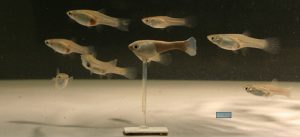Using a robotic fish to investigate individual differences in social responsiveness in the guppy
Posted on: 26 June 2018
Preprint posted on 19 April 2018
Article now published in Royal Society Open Science at http://dx.doi.org/10.1098/rsos.181026
The robotic fish are coming - to socialise! Bierbach et al. use a magnet controlled, 3D-printed fish replica to study social responsiveness in guppies.
Selected by Rasmus ErnCategories: animal behavior and cognition
Background:
Responding towards the actions of others is one of the most important behavioral traits whenever animals of the same species interact. Studies on the social responsiveness of fishes may improve our understanding of the spatial and temporal behaviour of this important group in the wild.
When assessing the social responsiveness of fishes towards conspecifics (members of the same species), mutual influences among interacting individuals makes it difficult to isolate the responsiveness of individual animals. The use of biomimetic robots allows researchers to circumvent this issue, but requires that the robots are accepted as conspecifics by the study species.
In the first part of this study, Bierbach et al. assessed if a magnet controlled, 3D-printed fish replica (Robofish) is accepted as conspecific by guppies (Poecilia reticulate), and if individual guppies differ in their social responsiveness.

Figure 1 Guppy replica with a group of female guppies in the test arena.
Behavioral traits may form correlated suits, so-called behavioral syndromes. An example of this is sticklebacks, where individuals with increased ‘boldness’ or ‘exploration behavior’ are less attracted by other individuals.
In the second part of this study, Bierbach et al. assessed if individual differences in social responsiveness in P. reticulate are linked to boldness and activity.
Methods:
For the first part, a focal fish and a companion (Robofish or another live fish) were released in a glass tank, and their movement patterns determined via video tracking equipment. Social responsiveness was assessed via the distance between the focal fish and the companion (Inter-individual distance, IID), the strength with which focal fish adjust their own movement towards that of the companion’s movement (Time-lagged cross-correlation of velocity vectors, TLXC), and the flow of movement information between the focal fish and the companion (Transfer Entropy, TE).
For the second part, a focal fish was introduced into an opaque plastic cylinder with a small opening, sealed with a sponge. Boldness was estimated from the time it took the fish to leave the cylinder when the sponge was removed. Social responsiveness was assessed via a Robofish positioned immediately outside the cylinder. Activity was estimated from the mean velocity over a 3 min period after removal of the Robofish.
Findings:
Overall, the distance between subjects was longer (IID), velocity correlations were less pronounced (TLXC), and information transfer rates were lower (TE) when focal fish were paired with Robofish. This dampened interaction pattern was attributed to the lack of mutual responsiveness present when focal fish were paired with live companions. Despite these differences, individuals exhibited consistent differences in responsiveness when interacting with a Robofish and a live companion, indicating that Robofish is accepted as conspecific by P. reticulate.
Social responsiveness was not correlated with boldness or activity, indicating that it is not part of a behavioral syndrome with these two correlating traits.
Interest:
I recently conducted a study on hypoxia avoidance behavior in red drum (Sciaenops ocellatus). Experimental trials were performed on individual fish under controlled laboratory conditions. For the results to be useful from an environmental change perspective, I need to know if hypoxia avoidance behavior in the laboratory is representative of avoidance behavior in the wild. Reading this article made me think that for schooling fish species, it is also necessary to know if hypoxia avoidance behaviour of individual fish is representative of the fishes’ avoidance behaviour when they are schooling.
Future directions:
It would be interesting to test if the acceptance of Robofish as a conspecific by P. reticulate is retained in the presence of external stressors (e.g., predator odours or aquatic hypoxia). If acceptance is retained, futures studies could assess the degree to which (predator or hypoxia) avoidance behaviour is governed by the behavior of leading individuals (see related literature).
Related literature:
Bierbach et al. (preprint). Guppies prefer to follow large (robot) leaders irrespective of own size. Doi: https://doi.org/10.1101/320911
Read preprintSign up to customise the site to your preferences and to receive alerts
Register hereAlso in the animal behavior and cognition category:
Responses to conflicting binocular stimuli in mouse primary visual cortex
Maitri Manjunath
Effects of transcranial photobiomodulation on peripheral biomarkers associated with oxidative stress and complex IV activity in the prefrontal cortex in rats subjected to chronic mild stress
Rickson Ribeiro, Marcus Oliveira
Psychedelics Align Brain Activity with Context
Loïk Holdrinet et al.
preLists in the animal behavior and cognition category:
Biologists @ 100 conference preList
This preList aims to capture all preprints being discussed at the Biologists @100 conference in Liverpool, UK, either as part of the poster sessions or the (flash/short/full-length) talks.
| List by | Reinier Prosee, Jonathan Townson |
9th International Symposium on the Biology of Vertebrate Sex Determination
This preList contains preprints discussed during the 9th International Symposium on the Biology of Vertebrate Sex Determination. This conference was held in Kona, Hawaii from April 17th to 21st 2023.
| List by | Martin Estermann |
Bats
A list of preprints dealing with the ecology, evolution and behavior of bats
| List by | Baheerathan Murugavel |
FENS 2020
A collection of preprints presented during the virtual meeting of the Federation of European Neuroscience Societies (FENS) in 2020
| List by | Ana Dorrego-Rivas |











 (No Ratings Yet)
(No Ratings Yet)